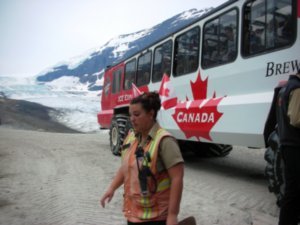Advertisement
Published: July 23rd 2008

 Canada Day
Canada Day
This girl was making sure we all got on the right Ice Explorers. I guess she was ready to celebrate Canada DayEarly in the morning of our first day in Whistlers and just enjoying a cuppa tea, the crows set up a lot of commotion as they chased a coyote from their territory. The animal ran down the pathway right past the motor home, we would have been able to get a great shot but the guy next to us was busy cleaning his windshield so as soon as the coyote saw him he really sped up, so my pictures are completely blurred. We settled down to breakfast when we could hear a squeak, looked out of the door to see a herd of mule deer (does and fawns) walking through the park. More excitement, they were so used to humans they didn’t flinch so we got some good photos. There are a lot of mule deer in the Jasper area so we became quite blasé about seeing them.
A visit the Columbia Icefields is a must when a person travels to this area. We left our visit until Tuesday (Canada Day) to try to avoid some of the weekend crowds. As you can see from the photo of the “Ice Explorer” of today, things have definitely changed since we visited in

 Ice Explorers
Ice Explorers
These are the new modern heated and cooled vehicles that go out on the glacier. The guide (bus driver) told us that the tires only have 15 lbs of pressure1980. A new Welcome Center has been built which contains an interpretive center, and all the usual commercial outlets and a restaurant.
Canada has experienced four major Ice Ages. The Athabasca Glacier and the Columbia Icefield once formed part of an enormous ice sheet that ground and carved the landforms that are seen today throughout the Rocky Mountains. At one time, the Athabasca Glacier flowed north to the present site of Jasper, and joining other glaciers, moved east to the prairies and south past Calgary. Its journey of hundreds of miles took many centuries. The most recent Ice Age ended of 10,000 years ago. Most glaciers in North America are still in retreat, as the summer’s melt is greater than the winters’ accumulation.
We visited after a very hot weekend in the mountains so the melt was quite visible. We could only see a small portion of the Icefield which covers 130 square miles. The Athabasca Glacier is just one of many glaciers fed by the Icefield. The average elevation is 10,000’ although the highest point is Mount Columbia which is 12284’ and the average snowfall is about 23’/year. The Columbia Icefield drains into the Pacific, Arctic and Atlantic Oceans.

 Shake & Bake
Shake & Bake
This is the "Ice Explorer" we rode on in 1980. They called it "shake and bake" because it had no air conditioning and the ride was a less than luxurious. The vehicle of course is an old Greyhound bus on tank tracksWe were in for some more excitement in our day. We were about half way back to Jasper when out from behind a culvert appeared a brown nose, there was a mother black bear and her cub—obviously by his/her size born this year. As soon as she saw us she took off into the undergrowth with cub hot on her heels, but I did manage to get one good shot of the two of them, and a great shot of the baby’s paw pads.
We got back to the motor home and enjoyed some well earned refreshment followed by a dinner of red beans and rice and some great Bellville Poffenberger sausage.
Advertisement
Tot: 0.193s; Tpl: 0.012s; cc: 16; qc: 65; dbt: 0.0859s; 1; m:domysql w:travelblog (10.17.0.13); sld: 1;
; mem: 1.1mb

 Canada Day
Canada Day
 Ice Explorers
Ice Explorers
 Shake & Bake
Shake & Bake




























